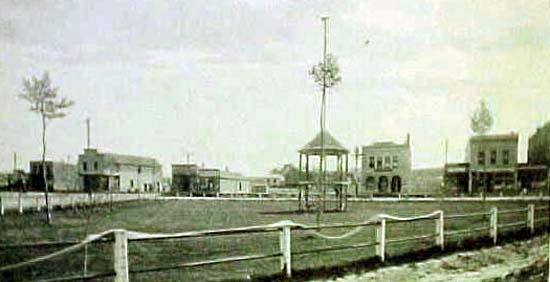
The Triangle, Kemmerer, Wyoming, approx. 1900, Photo by J.B.Roberts
Kemmerer does not have a town square; it has, instead, a triangle. The gazebo was removed by the 1920's. In the 1920's up to 1933, the
fire department would in the winter construct earthen dikes around the Triangle and flood the park
to create an ice skating rink. In February 2001, ice skating in the Triangle returned for
the first time in 68 years.
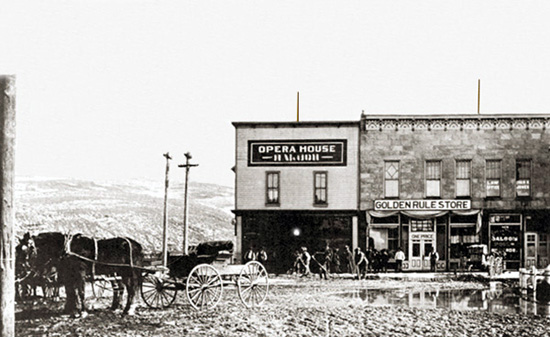
Golden Rule Store, approx. 1908
The store depicted is the second store, replacing the first store. Next door to the Golden
Rule Store on the right is a saloon. Over the saloon is a law office. Next door to the left is the
Opera House and a saloon. As depicted in the next photo, every building on the street housed a
saloon. The sign
over the door of the store says, "One Price." The Golden Rule Stores are the predecessor to today's
giant retailer the J. C. Penney Company and which received their start in Kemmerer. The store
depicted is the second location in Kemmerer for the Golden Rule Store. The first was a
wooden, false-fronted structure located between a laundry and a boarding house. As of August
2003, the building depicted was still in existence and housed a closed used furniture store.
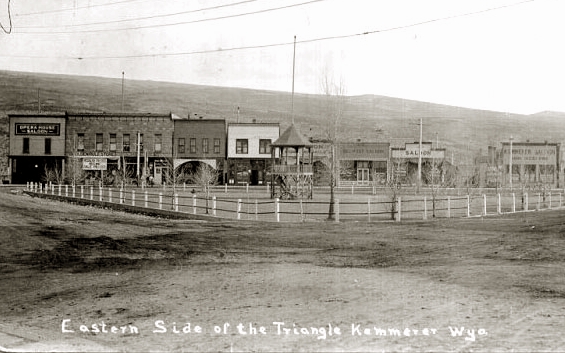
Saloons on east side of Triange, 1911.
Not withstanding that Penney was a religous teetotaler, his store was surrounded by saloons and by worse.
Indeed, when Penney opened, there were 21 saloons serving a population of about 1,000. One saloon was operated by Lyman
"Lime" Huggins, also referred to as "Preacher Lime." Huggins's saloon had various bon mots of morality over the back bar, including such as
"Don't buy a drink before seeing that your baby has shoes." One customer reckoned that he liked
Lime's saloon because he could sin and repent at the same time and "get the
whole thing over at once."
Every building in the above scene housed at least one saloon. Upstairs over one was the largest
sporting parlor in Kemmerer reachable by
a back stairway. The back stairway avoided public scrutiny.
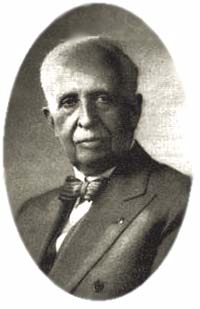
James Cash Penney
J. C. Penney (1875-1970) received his start in the retail business when he purchased a
butcher shop in Longmont, Colorado. The chef for one of Penney's major customers required a
kickback in form of a bottle of bourbon. When Penney refused, the account was
withdrawn, and Penney's business failed. In 1898, Penney went to work for Thomas M.
Callahan and William Guy Johnson of Fort Collins who operated a small chain of stores known as "Golden
Rule Stores." Penney was ultimately assigned to the company's store in Evanston. There,
Penney was such a success, Johnson and Callahan offered Penney the opportunity to become
a partner in a new Golden Rule store in Ogden, Utah. Penney declined Ogden, but, instead asked
for the opportunity to oen a store in Kemmerer.
On April 14, 1902, Penney opened the new Kemmerer "Golden Rule Store." Penney and his
wife were required to reside in the attic above the store. Water for the laundry had to be
hauled up to the attic in buckets using a pully. Notwithstanding, that the
new store did not offer credit and competed with the Kemmerer Coal Company's
store which did offer credit, the new enterprise was a success.
The first day's receipts totaled $466.59. By the end of the year the store had
grossed $28,898.00 and a net profit of $8,524.00. Penney's share of the
profits enabled him to pay off all debts and put $800.00 in the bank. The store was open
seven days a week, opening on Sundays at 9:00 a.m. In a short while, Penney was able to move to a modest cottage
at the edge of the commercial
district. In the 1970's the cottage was moved to a position across the
street from the Triangle.
With the sucess, in 1907, Callahan and Johnson offered Penney the opportunity to
buy the Kemmerer operation and two other stores. As new stores opened, Penney offered his managers
an opportunity to buy an interest in their stores. This provided an
incentive and guaranteed the sucess of the chain. With further growth and in order
to be nearer suppliers, Penney moved to Salt Lake City and later to New York.
He also developed business interest in Florida where he invested in a bank and a
dairy and cattle operation known as "Penney Farms" in the northeast section of Florida.
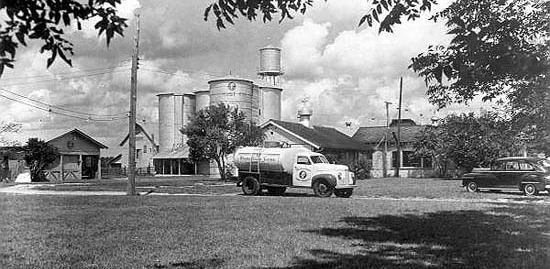
Penney Farms, Florida. Photo courtesy
Florida Bureau of Archives, Tallahassee, Florida.
The "F" on the water tank and the truck denote "Foremost." Today's Foremost
Dairies are descended from Penney's operations and received their name from
Penney's prize Guernsey bull, Langwater Foremost. With the Florida crash of
1928, Penney lost his personal fortune, but with the clothing company soon rebuilt
it. Penney Farms today survives as a retirement community.
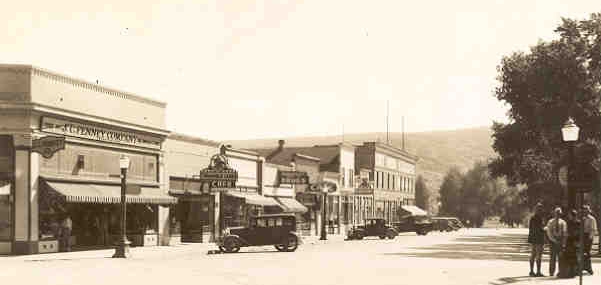 Kemmerer, about 1930, Triangle to right.
The J. C. Penney store depicted in photo opened in 1929 and was the third location for the
store.
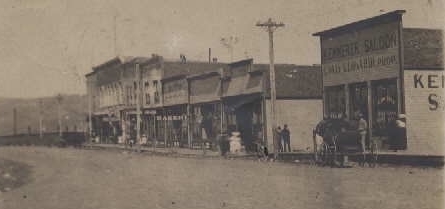
Kemmerer, Wyoming, 1907
Next page: Kemmerer continued.
|








